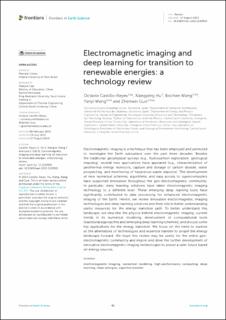| dc.contributor.author | Castillo-Reyes, Octavio | |
| dc.contributor.author | Hu, Xiangping | |
| dc.contributor.author | Wang, Bochen | |
| dc.contributor.author | Wang, Yanyi | |
| dc.contributor.author | Guo, Zhenwei | |
| dc.date.accessioned | 2023-11-16T06:52:17Z | |
| dc.date.available | 2023-11-16T06:52:17Z | |
| dc.date.created | 2023-08-17T09:37:51Z | |
| dc.date.issued | 2023 | |
| dc.identifier.citation | Frontiers in Earth Science. 2023, 11 . | en_US |
| dc.identifier.issn | 2296-6463 | |
| dc.identifier.uri | https://hdl.handle.net/11250/3102859 | |
| dc.description.abstract | Electromagnetic imaging is a technique that has been employed and perfected to investigate the Earth subsurface over the past three decades. Besides the traditional geophysical surveys (e.g., hydrocarbon exploration, geological mapping), several new applications have appeared (e.g., characterization of geothermal energy reservoirs, capture and storage of carbon dioxide, water prospecting, and monitoring of hazardous-waste deposits). The development of new numerical schemes, algorithms, and easy access to supercomputers have supported innovation throughout the geo-electromagnetic community. In particular, deep learning solutions have taken electromagnetic imaging technology to a different level. These emerging deep learning tools have significantly contributed to data processing for enhanced electromagnetic imaging of the Earth. Herein, we review innovative electromagnetic imaging technologies and deep learning solutions and their role in better understanding useful resources for the energy transition path. To better understand this landscape, we describe the physics behind electromagnetic imaging, current trends in its numerical modeling, development of computational tools (traditional approaches and emerging deep learning schemes), and discuss some key applications for the energy transition. We focus on the need to explore all the alternatives of technologies and expertise transfer to propel the energy landscape forward. We hope this review may be useful for the entire geo-electromagnetic community and inspire and drive the further development of innovative electromagnetic imaging technologies to power a safer future based on energy sources. | en_US |
| dc.language.iso | eng | en_US |
| dc.publisher | Frontiers Media S. A. | en_US |
| dc.rights | Navngivelse 4.0 Internasjonal | * |
| dc.rights.uri | http://creativecommons.org/licenses/by/4.0/deed.no | * |
| dc.title | Electromagnetic imaging and deep learning for transition to renewable energies: a technology review | en_US |
| dc.title.alternative | Electromagnetic imaging and deep learning for transition to renewable energies: a technology review | en_US |
| dc.type | Peer reviewed | en_US |
| dc.type | Journal article | en_US |
| dc.description.version | publishedVersion | en_US |
| dc.source.volume | 11 | en_US |
| dc.source.journal | Frontiers in Earth Science | en_US |
| dc.identifier.doi | 10.3389/feart.2023.1159910 | |
| dc.identifier.cristin | 2167583 | |
| cristin.ispublished | true | |
| cristin.fulltext | original | |
| cristin.qualitycode | 1 | |

